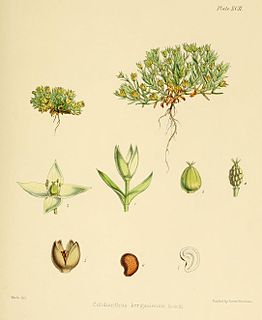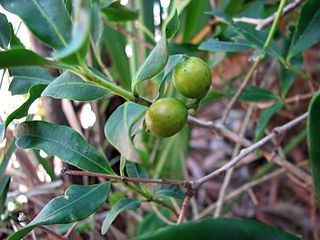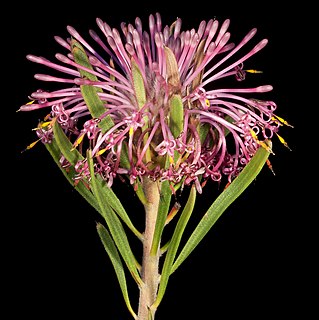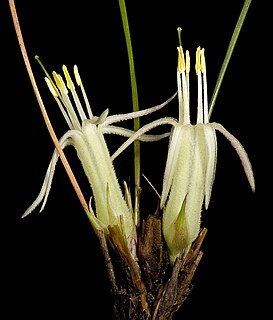
Christmas Island, officially known as the Territory of Christmas Island, is an Australian external territory comprising the island of the same name. It is located in the Indian Ocean, around 350 kilometres (220 mi) south of Java and Sumatra and around 1,550 km (960 mi) north-west of the closest point on the Australian mainland. It lies 2,600 km (1,600 mi) northwest of Perth and 1,327 km (825 mi) south of Singapore. It has an area of 135 square kilometres (52 sq mi).

The Piperaceae, also known as the pepper family, are a large family of flowering plants. The group contains roughly 3,600 currently accepted species in 5 genera. The vast majority of peppers can be found within the two main genera: Piper and Peperomia.

Exocarpos cupressiformis, with common names that include native cherry, cherry ballart, and cypress cherry, belongs to the sandalwood family of plants. It is a species endemic to Australia. Occasionally the genus name is spelt "Exocarpus" but it appears to be mostly no longer in use.

Blandfordia grandiflora, commonly known as Christmas bells, is a flowering plant endemic to eastern Australia. It is a tufted perennial herb with narrow, channelled, linear leaves and between two and twenty large, drooping, bell-shaped flowers. The flowers are red with yellow tips, or sometimes entirely yellow. It is one of four species of Blandfordia known as Christmas bells, this one growing on the coast and nearby ranges between Sydney in New South Wales and Fraser Island in Queensland.

The flora of Australia comprises a vast assemblage of plant species estimated to over 20,000 vascular and 14,000 non-vascular plants, 250,000 species of fungi and over 3,000 lichens. The flora has strong affinities with the flora of Gondwana, and below the family level has a highly endemic angiosperm flora whose diversity was shaped by the effects of continental drift and climate change since the Cretaceous. Prominent features of the Australian flora are adaptations to aridity and fire which include scleromorphy and serotiny. These adaptations are common in species from the large and well-known families Proteaceae (Banksia), Myrtaceae, and Fabaceae.

Eucalyptus rossii, commonly known as inland scribbly gum or white gum, is a species of small to medium-sized tree that is endemic to New South Wales and the Australian Capital Territory. It has smooth bark with insect scribbles, lance-shaped adult leaves, flower buds in groups of between nine and fifteen, white flowers and hemispherical or shortened spherical fruit.
Zeuxine exilis, commonly known as Ridley's jewel orchid or the slender jewel orchid, is a species of orchid that is endemic to Christmas Island where it grows in rainforest. It has three or four egg-shaped leaves and up to thirty small, dull reddish flowers crowded along a thin, hairy flowering stem. It was first recorded in 1904 but was not seen again until 2009.

Hoya aldrichii , commonly known as the Christmas Island Waxvine is a species of flowering plant in the Apocynaceae or dogbane family. It is a vine that is endemic to Christmas Island, an Australian territory in the north-eastern Indian Ocean, where it is a common epiphyte in the shrublands of the island's coastal terraces. The specific epithet honours Captain Aldrich, commander of the survey vessel HMS Egeria, which visited Christmas Island in 1887.
Ischaemum nativitatis, commonly known as the Christmas Island duck-beak, is a tropical grass in the family Poaceae. It is endemic to Christmas Island, an Australian territory in the north-eastern Indian Ocean. The specific epithet comes from the Latin nativitas ("birth") referring to the birth of Christ, or Christmas, after the name of the island.
Colubrina pedunculata is a shrub in the family Rhamnaceae. It is endemic to Christmas Island, an Australian territory in the north-eastern Indian Ocean. Its specific epithet comes from the Latin pedunculatus, referring to the long and conspicuous peduncle of the inflorescence.

Ehretia microphylla, synonym Carmona retusa, also known as the Fukien tea tree or Philippine tea tree, is a species of flowering plant in the borage family, Boraginaceae.

Colobanthus kerguelensis is a low-growing, moss-like flowering cushion plant in the family Caryophyllaceae, found on subantarctic islands in the southern Indian Ocean. The specific epithet refers to the type locality – the Kerguelen Islands.

Persoonia myrtilloides, commonly known as myrtle geebung, is a plant in the family Proteaceae and is endemic to New South Wales. It is an erect to spreading shrub with elliptic to egg-shaped leaves and yellow flowers in groups of up to forty on a rachis up to 170 mm (6.7 in) long.

Prostanthera stenophylla is a species of flowering plant in the family Lamiaceae and is endemic to Wollemi National Park in New South Wales. It is an erect, slender, aromatic shrub with hairy, oblong leaves and small groups of pale bluish mauve to violet flowers.

Peperomia galioides is a species of plant in the family Piperaceae, endemic to Peru. Galioides has petioles of less than 1mm long and leaves between 5-30mm. The leaves of the plant were collected in the Bogotá Botanical Garden, the leaves were then air-dried and its oil abstracted via Clevenger hydrodistillation. It was traditionally used in Peruvian herbal medicine.

Alyxia spicata, commonly known as chain fruit, is a sprawling shrub or vine in the family Apocynaceae. It is native to New Guinea and the Australian tropics.
Persoonia hakeiformis is a species of flowering plant in the family Proteaceae and is endemic to the south-west of Western Australia. It is an erect or spreading to low-lying shrub with mostly smooth bark, linear leaves and bright yellow flowers borne in groups of up to sixty along a rachis up to 100 mm (3.9 in) long.

Isopogon longifolius is a small shrub in the family Proteaceae that is endemic to the southwest of Western Australia.

Isopogon linearis is a small shrub in the family Proteaceae that is endemic to the southwest of Western Australia.

Conostylis androstemma is a tufted perennial plant species in the family Haemodoraceae. It is endemic to the south-west of Western Australia. Plants grow to between 10 and 30 cm high and produce cream to pale yellow flowers between May and August in the species' native range.















